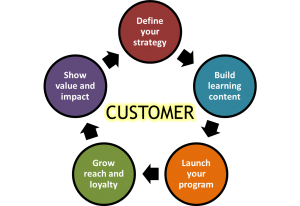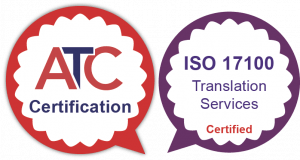
This post is the second in a series from Christine Yoshida, President & Principal Consultant of Enlitefy, Inc.
With over 20 years’ experience with some of the largest program sponsors in IT, Christine has in-depth expertise in creating, launching, and managing successful certification programs that benefit millions of IT workers around the world for Apple, Intel, Cisco, Microsoft, LinkedIn, and Blue Jeans Network. Christine also offers training and certification consulting services through Enlitefy, Inc.
In my last post, I shared my five-phase process for building a certification program that puts your customer at the center. I reviewed the first phase in which you define your strategy, with the goal of definitively answering the “Why Certification” question from your customer’s point of view. I also discussed steps you can take to develop a roadmap for your program. In this post, I’ll focus in on the next phase of the process: building learning content.

Build for Customers, by Customers
In the second, “building” phase, your primary goal is to create content that solves the customer problems you identified in the first “strategy” phase. Using the roadmap as your guide, continue to engage customers in content design and development processes as you build out each component. Treat them as your best friend, and take all opportunities to continually show your appreciation of the hard work they’ll be doing in the three key milestones of this phase—exam design, content development, and beta testing.
Exam Design
Begin your design process by bring SMEs together for several days to define the creating an exam “blueprint” that specifies all of the skills that will be validated by the certification program. Involving customers in this step is critical to ensuring that your content best represents the solution they need. It’s best to retain a psychometrician from the beginning, who can facilitate and guide the SMEs to ensure that the exam(s) meets industry quality and legal defensibility standards.
Depending on the detail you’ve defined in your roadmap, you may need to precede the blueprinting activity with a shorter SME session to review and refine the goals, objectives, and components of the program, which will help your SMEs enter into the blueprinting workshop with a solid, shared vision for the program.
Be sure to include customers who can represent your target audience. For example, if your certification program will service a global audience, include SMEs from Europe, Latin America, and Asia who will be able to flag content that unintentionally favors a U.S or Western audience. Avoid taking the easier route of including only your internal organization’s SMEs, which can result in narrowly-focused content that does not sufficiently address the customer’s needs.
Content Development
Once you have the first blueprint completed, you can use this as a guide for your SMEs to develop the exam items. Bring your SMEs together for several days to write and review each exam item according to the blueprint. Also at this time, you can launch instructional design processes such as course design document creation and training material development. Involve your SMEs in reviews of the instructional materials too—this will ensure that these important components meet your customer’s particular needs. One caveat—you may wish to create a separate SME pool for reviewing instructional content, to avoid a situation in which this content is limited to “teaching to the test.”
Beta Testing
Once you have a “minimally viable product” (MVP)—a set of components developed to the point that customers will accept them without investing added time for everything to be brought to the point of perfection—run one or more beta tests with a fresh pool of customers who best represent the target audience. Gather feedback at all opportunities—this can be done through surveys, through informal focus groups, and by observing exam performance. To speed up your time to market and cultivate a base of loyal customers ahead of launching the program, you may wish to “soft-launch” your program to “early adopter” customers who are willing to serve as beta testers and who will be offered the opportunity to earn certification as a result of their participation if they successfully pass the exam. In this case, your beta deliveries of the educational and exam components would be considered “operational,” and after making post-beta adjustments you’d conduct a fully-fledged launch using the improved version of the components.
Other posts in this series
[row]
[column md=”4″]

[column md=”8″]
Developing a Certification Program (Part 1): Defining Your Strategy
In this post we look at the first in a series of steps to be addressed when developing a certification program: strategy.
[/column]
[/row]
[row]
[column md=”4″]

[column md=”8″]
Developing a Certification Program (Part 3): Launching the Program
In the third, “launching” phase, take your closest customers with you as you announce your program.
[/column]
[/row]




